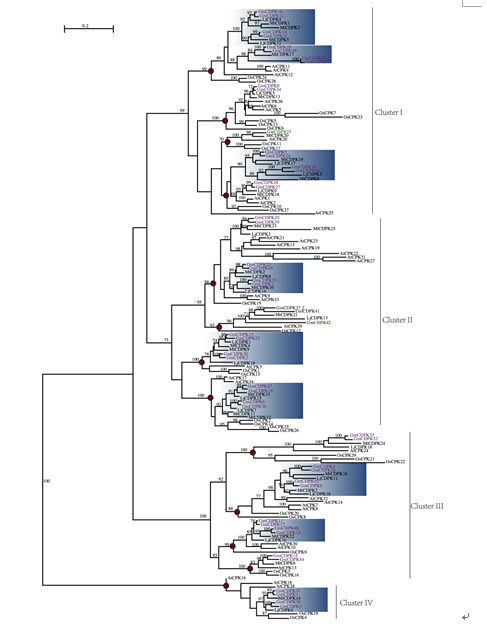Soybean (Glycine max) is one of the most important crops, and insects and drought cause large economic losses in soybean production every year.
Ca2+ is a ubiquitous second messenger that is critical for signal transduction in eukaryotes by activating various cellular processes in response to developmental and stress stimuli. Calcium-dependent protein kinases (CDPKs) are plant-specific calcium sensors that play important roles in various aspects of plant physiology.
Prof. WU Jianqiang’ team at the Kunming Institute of Botany, Chinese Academy of Sciences (CAS) investigated how CDPK members respond to drought and herbivory in soybean, phylogenic relationships, chromosomal locations, gene structures, and tissue-specific, herbivory- and drought-induced expression profiles of soybean GmCDPKs were investigated.
Fifty GmCDPK genes were identified by bioinformatic analysis, which phylogenetically grouped into 4 distinct clusters and distributed across 13 sub-clusters. Individual classes of GmCDPKs harbor highly conserved mRNA splicing sites, and their exon numbers and lengths were consistent with the phylogenetic relationships, suggesting that at least 13 ancestral CDPK genes had emerged before the split of monocots and eudicots.
Gene expression analysis indicated that several GmCDPKs were tissue- specific expressed. GmCDPKs’ transcript levels changed after wounding, exhibited specific expression patterns after simulated Spodoptera exigua feeding or soybean aphid (Aphis glycines) herbivory, and were largely independent of the phytohormones jasmonic acid and salicylic acid.
The most pronounced transcriptional responses were detected after drought and abscisic acid treatments with more than half of all GmCDPKs being upregulated, suggesting their important roles during abiotic stress responses in soybean. Our data provide an important foundation for further functional dissection of GmCDPKs, especially in the context of soybean-insect interactions and drought stress adaptation.
The study has recently been published online in Scientific Reports: https://www.ncbi.nlm.nih.gov/pmc/articles/PMC4702179/
This work was supported by the Strategic Priority Research Program of the Chinese Academy of Sciences, the Yunnan Recruitment Program of Experts in Sciences, the Natural Science Foundation of China, and the Young International Scientists Program from the Chinese Academy of Sciences.

Figure 1. Phylogenetic relationship of soybean, Arabidopsis, Lotus japonicas, Medicago truncatula, and rice CDPKs (Image by KIB)
Department of Economic Plants and Biotechnology
Yunnan Key Laboratory for Wild Plant Resources
Kunming Institute of Botany, Chinese Academy of Sciences
Prof. Dr. WU Jianqiang
Email: wujianqiang@mail.kib.ac.cn




